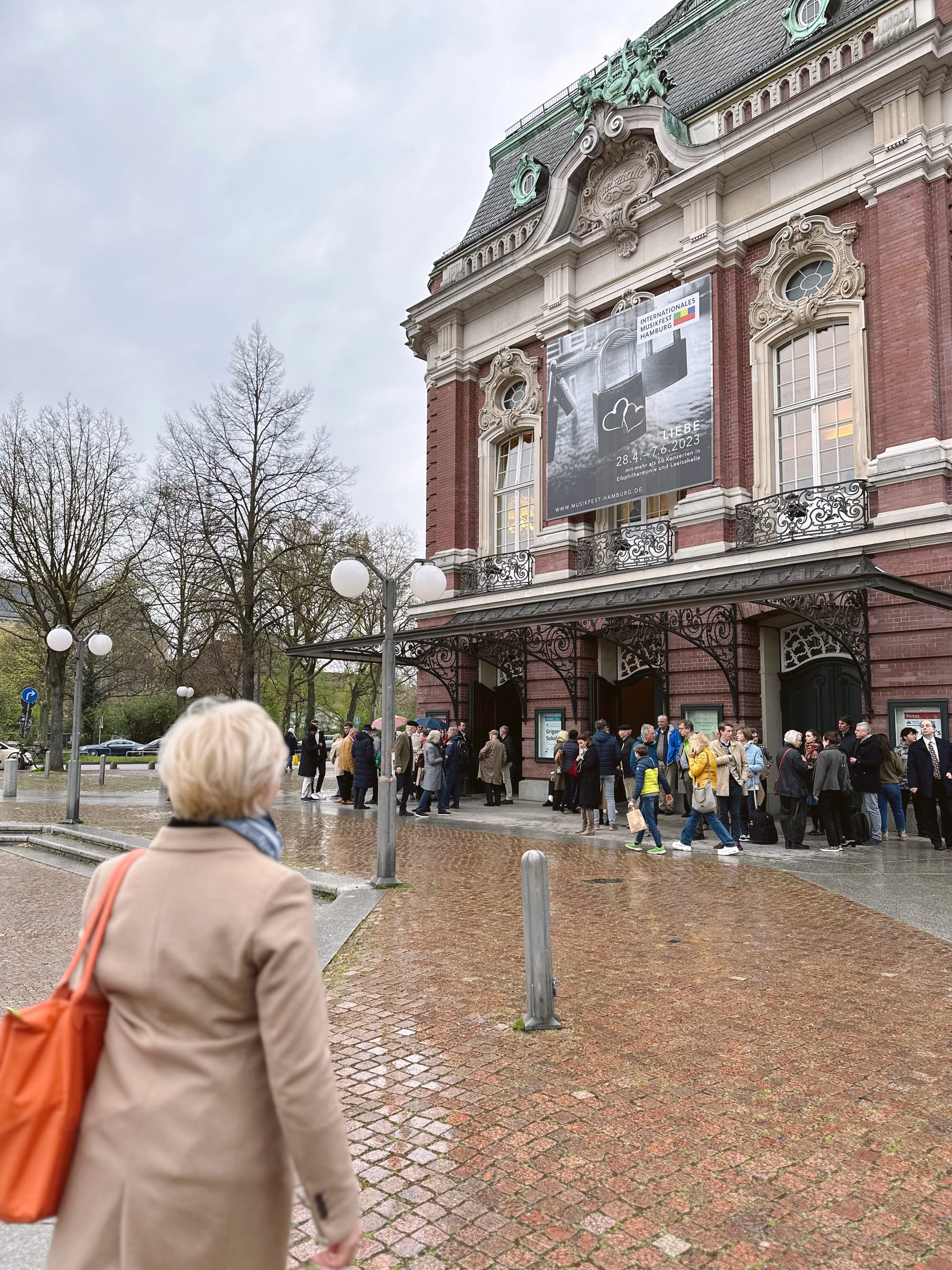What does Maria Callas and Grigory Sokolov have in common?🎼

Germany, Hamburg, Friday the 28th of April 2023, at 7:30 pm.
We had woken up early for a morning flight, flown to Bremen, driven to Hamburg and walked around the city, when the evening came and it was time to familiarize ourselves with the local culture of classical music. We walked with a slight haste in the light rain and I was mentally jumping up and down from the joy of knowing that I get to go to a concert in such an important city of Western art music, that is, Hamburg.
At last the beautiful neo-baroque building stood before us. We took a couple of pictures and walked inside. Laeiszhalle, previously known as Musikhalle, was built in 1908 and its stage has seen a remarkable number of significant moments in the history of Western art music. Of course, the hall is not that old when comparing with many other European concert halls, but it is still incredible to think that, for example, Richard Strauss, Sergey Prokofiev, and Igor Stravinsky have conducted their own compositions there. In addition for example world-renowned violinists such as Yehudi Menuhin and Vladimir Horowitz have performed there in their youth. But most importantly for me: Maria Callas has performed at Laeiszhalle.
Maria Callas at Laeiszhalle
As we walked through the main doors and I grabbed the door handle, we joked about whether Maria Callas might have touched this very handle back in the day. Then we realized that she must have entered the building through the backstage door. Now that I think about it, even if she had entered through the main doors at some point, she probably wouldn't have opened the door herself; a gentleman would have likely opened it for her.😆
In any case, Maria Callas's concerts in Hamburg gave me the idea to come to this concert. Callas performed at Laeiszhalle during her German tours in 1959 and 1962, and both concerts are very familiar to me because there are complete video recordings of them, and I have watched them quite a lot. Both concerts were televised at the time and are now available to watch in full on YouTube. There aren't many video recordings of Callas' other concerts, so these two concerts are essential for studying her performance practice, charisma and singing. For my bachelor's thesis, I analyzed her performance of George Bizet's aria "L'amour est un oiseau rebelle" (also known as "Habanera") from the opera Carmen (1875) in the concert from 1962, so that concert is especially familiar to me.
Links to the concert recordings and interviews:
- Callas' concert in Hamburg in 1959
- Callas' concert in Hamburg in 1962
- Callas' concert in Hamburg in 1962 in color, but with a slightly worse video quality
- Callas' interview on her tour in Germany (Munich 1959)
- Callas' interview on her tour in Germany (Munich 1962)
While watching these recordings, it’s important to note that although Callas’ performance is top-notch when it comes to the interpretation, she had significant vocal issues in both concerts. In the 1959 concert, she had the flu, but since canceling the concert was probably not an option, she bravely sang through it (while still looking incredibly elegant). During a fast passage in one piece, her voice even breaks momentarily, but she still sings most of the arias astonishingly well considering that her voice was far from healthy.
In the 1962 concert, Callas was healthy, but her voice was strained from a long career and an overly demanding workload, so her higher notes especially lacked the ease heard in her earlier recordings. Nonetheless, the 1962 concert is one of my favorites to watch because her expressions and masterful interpretation of the arias are so fascinating to observe.
Grigory Sokolov at Laeiszhalle
Back to the present. Although in my mind’s eye I saw Maria Callas on Laeiszhalle’s stage, with my physical eyes I saw a rather short man wearing a tailcoat, the legendary pianist Grigory Sokolov. Sitting in the hall, all I could think about was that he is actually a perfect example of preserving the tradition of classical music that is both very serious and somehow sweet and indulgent. His way of performing is as understated as can be, but there’s really is no need for dramatic gestures as he communicates so skillfully through the music he plays. It's possible that his emotional involvement was reflected in his expressions while playing, but I couldn’t distinguish his expressions clearly from where we were sitting.
In the first part of the concert, Sokolov played quite a medley of works by Henry Purcell (1659–1695). At times, I felt I would have gotten much more out of these pieces if I were a more informed listener of the various musical gestures and figures of Baroque music. Baroque music is full of different expressions of emotions, and it was typically done systematically using certain musical symbols and figures known to the audience of that time. Despite not quite distinguishing these nuances of the music of Purcell, listening to it felt like a pleasant time travel to 17th-century Britain and somehow calming—almost therapeutic—because the music presented a nice mix of steady and robust parts and more virtuosic sections.
In the second half of the concert, we moved to a more familiar atmosphere as Sokolov played two pieces by Mozart. They were entertaining to listen to, and it was wonderful to see how the audience’s admiration and appreciation for Sokolov deepened moment by moment. In the end, the audience got Sokolov to perform six or seven encores, and the atmosphere kept intensifying with each piece. I had never been to a concert with so many encores before, but it was fascinating to see how "crazy" this German audience was about Sokolov’s playing.
The Audience at Laeiszhalle
Yes, the audience sitting in the hall just wanted to hear more. They didn’t want to end the shared moment with the music and head out into the rainy late night in Hamburg—which is, of course, completely understandable. But still, the kind of reverence the audience there had for classical music, or at least for listening to Sokolov, surprised me completely. It feels like I’ve never experienced quite that level of appreciation at a concert in Finland; enthusiasm and focus, yes, but not quite such devoted attention.
Then I found myself thinking about how many of the canonized composers in the history of Western art music are German or at least German-speaking. Just Bach, Beethoven, the Mendelssohns, the Schumanns, Schubert, Wagner, Brahms, Richard Strauss, Handel, Telemann, and Meyerbeer were German, and for example, Haydn, Mozart, and Johann Strauss Jr. were Austrian but still German-speaking. Sitting in the concert hall, it started to seem that the legacy of this group of "great composers" still lives strongly in German culture in the 2020s. Or of course there’s always the possibility that the particular audience was made up of such devoted fans of Sokolov that the atmosphere of the event was so intense because of that.😅
In any case, the demand for and popularity of Western art music in Hamburg is also indicated by the fact that Sokolov’s concert was not the only sold-out concert that night. Namely, the opening concert of the Hamburg International Festival of Classical Music, conducted by Kent Nagano at the Elbphilharmonie’s new concert hall, was also sold out. The Elbphilharmonie’s hall has a capacity of 2,100 people, and Laeiszhalle has 2,025, so from a Finnish perspective, it’s amazing that both concerts drew full audiences. Of course, there are so much more people in Germany than in Finland, but I still don’t assume it’s entirely evident that money is invested specifically in presenting Western art music and booking the world’s most renowned soloists and conductors.
In Conclusion
One of the things that I never want to forget from this concert experience is what the audience’s resounding applause sounded like at Laeiszhalle. Usually this sort of shoebox-shaped concert halls work very well acoustically, and indeed, the music, as well as the applauses sounded really good there. I loved the moment when a piece ended and the utmost silence and magical atmosphere suddenly broke with the deafening applause and shouts of "bravo". I thought instantly : this is probably what the applause sounded like when Callas performed in this hall. I’ve heard applauses for Callas only through recordings before, but now I got to hear what real applause sounds like in such a hall.
Besides listening to the music and applause, it was again nice to observe the music culture and concert behavior in a foreign country. I didn’t quite expect that this concert would be so different culturally from classical music concerts in Finland. Of course, I also tried my best to observe what kind of clothes people were wearing and how they looked different from Finns. Then I started wondering how all those people in the hall ended up at that particular concert ; on what basis they had chosen that concert and whether most of the audience had some background in classical music or if they generally enjoy listening to piano music. Such things can’t be determined from appearances, but it was clear that at least the audience members sitting near us were very particular about their listening experience and seemed to insist that the hall would be completely silent during the pieces.
The whole evening's mix of silence, music and applause was conducive to forgetting all my everyday thoughts and being fully in the moment both in my own internal world and together with two thousand other people packed like sardines in an old rectangular room. Could life get any better!!😜
Henry Purcell
A Ground in Gamut Z 645
Suite Nr. 2 g-Moll Z 661
A New Irish Tune G-Dur Z 646
A New Scotch Tune G-Dur Z 655
Trumpet Tune C-Dur ZT 678
Suite Nr. 4 a-Moll
Round'O ZT 684 / aus: Abdelazer-Suite Z 570
Suite Nr. 7 d-Moll
Chacone g-Moll ZT 680
Wolfgang Amadeus Mozart
Sonate für Klavier B-Dur KV 315c
Adagio h-Moll KV 540

Admiring the façade of the concert hall before going in ©Elle Palmu
